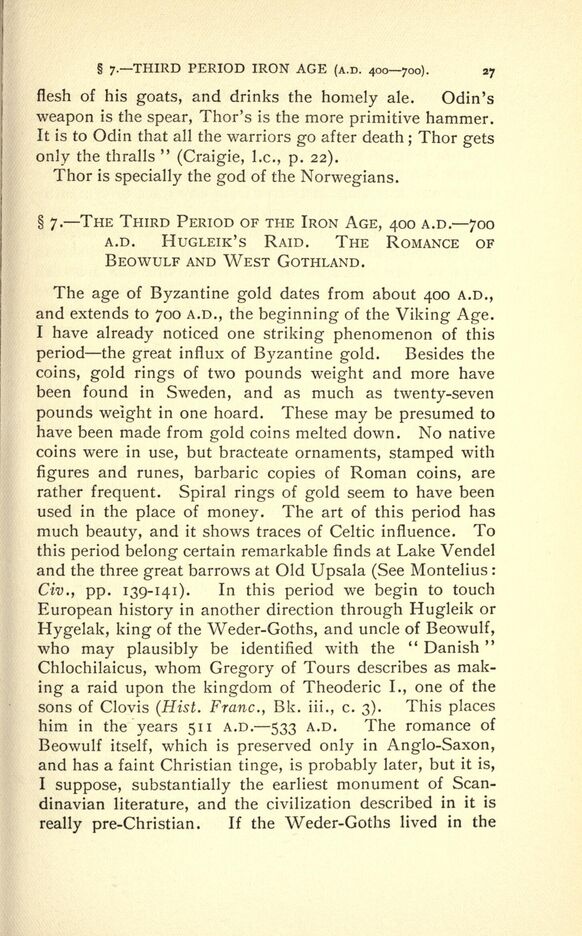
Full resolution (JPEG) - On this page / på denna sida - I. Introductory Lecture.—The Country and its Inhabitants in the Heathen Period up to 1000 A.D. - § 6. Second Period of the Iron Age - § 7. Third Period of the Iron Age

<< prev. page << föreg. sida << >> nästa sida >> next page >>
Below is the raw OCR text
from the above scanned image.
Do you see an error? Proofread the page now!
Här nedan syns maskintolkade texten från faksimilbilden ovan.
Ser du något fel? Korrekturläs sidan nu!
This page has never been proofread. / Denna sida har aldrig korrekturlästs.
7 . THIRD PERIOD IRON AGE (A.D. 400700). 27
flesh of his goats, and drinks the homely ale. Odin s
weapon is the spear, Thor s is the more primitive hammer.
It is to Odin that all the warriors go after death ;
Thor gets
only the thralls
"
(Craigie, I.e., p. 22).
Thor is specially the god of the Norwegians.
7. THE THIRD PERIOD OF THE IRON AGE, 400 A.D. 700
A.D. HUGLEIK S RAID. THE ROMANCE OF
BEOWULF AND WEST GOTHLAND.
The age of Byzantine gold dates from about 400 A.D.,
and extends to 700 A.D., the beginning of the Viking Age.
I have already noticed one striking phenomenon of this
period the great influx of Byzantine gold. Besides the
coins, gold rings of two pounds weight and more have
been found in Sweden, and as much as twenty-seven
pounds weight in one hoard. These may be presumed to
have been made from gold coins melted down. No native
coins were in use, but bracteate ornaments, stamped with
figures and runes, barbaric copies of Roman coins, are
rather frequent. Spiral rings of gold seem to have been
used in the place of money. The art of this period has
much beauty, and it shows traces of Celtic influence. To
this period belong certain remarkable finds at Lake Vendel
and the three great barrows at Old Upsala (See Montelius :
Civ., pp. 139-141). In this period we begin to touch
European history in another direction through Hugleik or
Hygelak, king of the Weder-Goths, and uncle of Beowulf,
who may plausibly be identified with the
"
Danish
"
Chlochilaicus, whom Gregory of Tours describes as mak
ing a raid upon the kingdom of Theoderic I., one of the
sons of Clovis (Hist. Franc., Bk. iii., c. 3). This places
him in the years 511 A.D. 533 A.D. The romance of
Beowulf itself, which is preserved only in Anglo-Saxon,
and has a faint Christian tinge, is probably later, but it is,
I suppose, substantially the earliest monument of Scan
dinavian literature, and the civilization described in it is
really pre-Christian. If the Weder-Goths lived in the
<< prev. page << föreg. sida << >> nästa sida >> next page >>